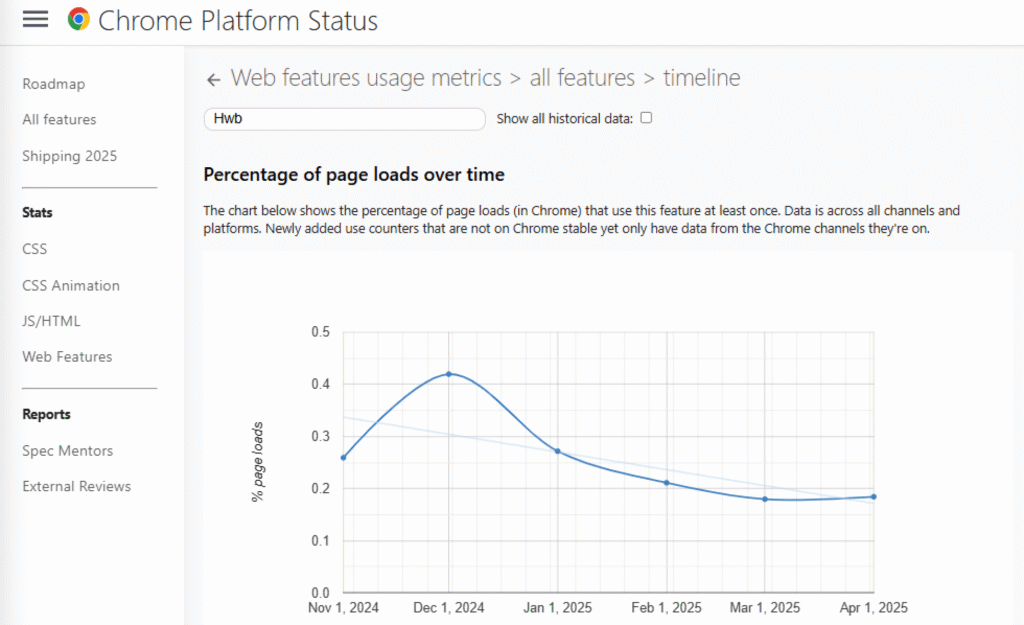Okay, nobody is an exaggeration, but have you seen the stats for hwb()? They show a steep decline, and after working a lot on color in the CSS-Tricks almanac, I’ve just been wondering why that is.

hwb() is a color function in the sRGB color space, which is the same color space used by rgb(), hsl() and the older hexadecimal color format (e.g. #f8a100). hwb() is supposed to be more intuitive and easier to work with than hsl(). I kinda get why it’s considered “easier” since you specify how much black or white you want to add to a given color. But, how is hwb() more intuitive than hsl()?
hwb()accepts three values, and similar tohsl(), the first value specifies the color’s hue (between0deg–360deg), while the second and third values add whiteness (0–100) and blackness (0–100) to the mix, respectively.
According to Google, the term “intuitive” means “what one feels to be true even without conscious reasoning; instinctive.” As such, it does truly seem that hwb() is more intuitive than hsl(), but it’s only a slight notable difference that makes that true.
Let’s consider an example with a color. We’ll declare light orange in both hsl() and hwb():
/* light orange in hsl */
.element-1 {
color: hsl(30deg 100% 75%);
}
/* light orange in hwb() */
.element-2 {
color: hwb(30deg 50% 0%);
}These two functions produce the exact same color, but while hwb() handles ligthness with two arguments, hsl() does it with just one, leaving one argument for the saturation. By comparison, hwb() provides no clear intuitive way to set just the saturation. I’d argue that makes the hwb() function less intuitive than hsl().
I think another reason that hsl() is generally more intuitive than hwb() is that HSL as a color model was created in the 1970s while HWB as a color model was created in 1996. We’ve had much more time to get acquainted with hsl() than we have hwb(). hsl() was implemented by browsers as far back as 2008, Safari being the first and other browsers following suit. Meanwhile, hwb() gained support as recently as 2021! That’s more than a 10-year gap between functions when it comes to using them and being familiar with them.
There’s also the fact that other color functions that are used to represent colors in other color spaces — such as lab(), lch(), oklab(), and oklch() — offer more advantages, such as access to more colors in the color gamut and perceptual uniformity. So, maybe being intuitive is coming at the expense of having a more robust feature set, which could explain why you might go with a less intuitive function that doesn’t use sRGB.
Look, I can get around the idea of controlling how white or black you want a color to look based on personal preferences, and for designers, it’s maybe easier to mix colors that way. But I honestly would not opt for this as my go-to color function in the sRGB color space because hsl() does something similar using the same hue, but with saturation and lightness as the parameters which is far more intuitive than what hwb() offers.
I see our web friend, Stefan Judis, preferring hsl() over hwb() in his article on hwb().
Lea Verou even brought up the idea of removing hwb() from the spec in 2022, but a decision was made to leave it as it was since browsers were already implementing the function. And although,I was initially pained by the idea of keeping hwb() around, I also quite understand the feeling of working on something, and then seeing it thrown in the bin. Once we’ve introduced something, it’s always tough to walk it back, especially when it comes to maintaining backwards compatibility, which is a core tenet of the web.
I would like to say something though: lab(), lch(), oklab(), oklch() are already here and are better color functions than hwb(). I, for one, would encourage using them over hwb() because they support so many more colors that are simply missing from the hsl() and hwb() functions.
I’ve been exploring colors for quite some time now, so any input would be extremely helpful. What color functions are you using in your everyday website or web application, and why?
More on color
Almanac
on
Feb 22, 2025
hsl()
Almanac
on
Mar 4, 2025
lab()
Almanac
on
Mar 12, 2025
lch()
Almanac
on
Apr 29, 2025
oklab()
Almanac
on
Apr 3, 2025
oklch()
Why is Nobody Using the hwb() Color Function? originally published on CSS-Tricks, which is part of the DigitalOcean family. You should get the newsletter.
Source: Read MoreÂ


